STORY, MEET STRATEGY
Let’s make marketing feel less robotic and more real.
Find resources that bring your message—and your business—to life.

2025 SA SME Funding Report Exposes Big Gaps—Here’s How to Get Your Share
By Vicky Sidler | Published 23 June 2025 at 16:00 GMT
Finfind’s latest MSME Access to Finance Report just landed, and it reads like a thriller—minus the happy ending.
Out of 10,000 funding requests, the smallest firms asked for the least money yet got shoved to the back of the line.
Welcome to the South African funding paradox: the businesses that create 80% of jobs struggle most to borrow lunch-money sized loans.
TL;DR
Micro-businesses (≤ R1 m turnover) filed 85.6 % of applications—and were rejected first.
Most SMEs only want ≤ R1 m, but consumer-style credit scoring mislabels them “high risk.”
Female-owned firms now make 36 % of requests, yet female-targeted products fell 33 %.
Funding is spreading beyond Gauteng; KZN, Eastern Cape, and Mpumalanga are heating up.
SA still lacks national SME-lending data, so gaps stay hidden.
Action plan: get funding-ready docs, try alternative lenders, and feed data to matching platforms.
If your message to lenders is muddy, no amount of hustle will help—start with a crystal-clear one-liner (see the 5-Minute Marketing Fix) before chasing cash.
What the Numbers Say:
Before we talk solutions, let’s look at what the data actually reveals—and it’s not what most people think.
10,000+ applications studied across 605 products from 315 lenders (Sep 2023–Aug 2024).
38.7% of SMEs asked for under R250,000; 30.8% wanted between R250,000 and R1 m.
37% of requests now originate outside Gauteng—a rising tide for outlying provinces.
Translation: entrepreneurs aren’t begging for billions; they’re seeking bridge funding, equipment upgrades, and breathing room.
Why Micro-Businesses Still Get Sidelined:
If you’ve ever tried getting a loan for your small business and felt like the system wasn’t built for you—you’re not imagining things. Most lenders still use credit-scoring tools designed for individuals, not businesses.
So instead of evaluating things like customer demand, supplier reliability, or consistent cash flow, the algorithm’s flagging a late cellphone payment from 2021.
That’s how a profitable street vendor with five employees gets turned down faster than a gym contract in July. Until lenders update their risk models to reflect how micro-businesses actually operate, good businesses will keep slipping through the cracks.
Trend Watch—Women Rise, Products Disappear:
Here’s a classic case of progress getting tripped by policy: more women than ever are applying for business funding—36.1% of all requests, to be exact.
But instead of rising to meet that demand, finance products specifically tailored to women-led businesses have dropped 33%.
That’s like more people lining up at your restaurant while you quietly take half the tables out. It’s not just bad optics—it’s bad economics.
What this tells us is clear: lenders and policymakers need to stop treating female entrepreneurship as a nice-to-have and start designing funding that actually fits the reality on the ground.
Data—The Invisible Barrier:
Everyone loves to talk about “supporting SMEs.” But without detailed national tracking of SME lending, those promises are built on guesswork.
The Reserve Bank’s BA900 forms still don’t separate SME lending data from the rest, making it nearly impossible to see who’s being served—and who isn’t.
That’s not just a policy oversight—it’s a strategic blind spot. When the numbers aren’t visible, funding gaps stay hidden, and no one’s held accountable.
Until we get transparency, micro-businesses are stuck building their own paper trails just to prove they exist.
Three Funding-Ready Moves You Control:
As a Duct Tape Marketing Strategist and StoryBrand Certified Guide, I know that you can’t control the lending climate—but you can control your readiness. Start here:
1️⃣ Get your paperwork photo-ready:
Most lenders don’t expect you to have a CFO. But they do expect basic financial hygiene. That means:
Up-to-date monthly or quarterly management accounts (Excel is fine—just be consistent)
A 12-month cash-flow forecast that shows where the money’s going
A valid tax clearance certificate (don’t get tripped up on admin)
Bonus points if you can show revenue trends or attach proof of repeat clients.
2️⃣ Cast a wider net:
Banks are picky, slow, and still warming up to micro-lending. But they’re not the only game in town. Explore:
Peer-to-peer lending platforms (like RainFin, FundingHub or Bridgement)
Invoice financing (turn unpaid invoices into short-term cash)
Equipment leasebacks (tap assets without selling them)
“Bank says no” shouldn’t be the end—it’s just level one. Think of it as unlocking the side quests.
3️⃣ Feed the algorithms good data:
Most matching platforms (like Finfind) run on algorithms. The more detail you give, the better your funding options become. Include:
Accurate industry codes
Specific funding purpose
Up-to-date turnover
BEE and ownership data
Think of it like Tinder for term loans: the clearer and more honest your profile, the better your match.
Get Clear. Get Competitive. Get Funded.
If banks won’t play ball, more paying customers might be the next best plan. A business that clearly explains what it does, who it helps, and why it’s worth buying from will always be in a better position to grow—even without outside funding.
That’s where the 5-Minute Marketing Fix comes in. It’s a free tool that helps you craft one sharp, simple sentence to explain your business—so prospects say “yes” faster and funders see real traction.
Because sometimes the fastest path to cash isn’t a loan. It’s better messaging.

Created with clarity (and coffee)






